
Meet the professional cuddler charging £70-an-hour to hug ‘the big spoons in life’
A professional cuddler who makes a living giving clients hugs has said people travel from all over the globe to receive the cuddle therapy she offers which is “far less intimate than a massage” and helps people from “all walks of life”. Natasha Wicks, 44, from Coventry, West Midlands, says that despite criticism, cuddling is scientifically proven to release happy hormones like dopamine and that a lot of her clients are “the big spoon in life” and go to her for emotional support that they do not have at home. As such, many of her clients are caregivers and most of them join Natasha for two-hour hugging sessions, costing £70 an hour. The sessions vary depending on what the client wants, some having “emotional hugs”, others talking more and some wanting to “sit at opposite ends of the sofa with our legs and feet entwined”. Natasha became a cuddle therapist in 2015 and, while she has had comments online from people criticising the practice, she said that her family and friends were unsurprised when she first started giving professional cuddles. She said: “They all said to me that I give the best cuddles so it’s not surprising that I’d start doing it as a job. “It’s very much what I do, I help people and want to make people feel better. It’s a natural thing when someone is going through a tough time to want to give them a hug. “Cuddle therapy might not be as widely accepted in society but it’s far less intimate than other things like massages which are seen as normal.” Prior to becoming a cuddler, Natasha originally trained as a CBT therapist and counsellor. She said: “There’d be situations where I would be talking to someone and they’d really need a hug, but obviously, you’d have professional boundaries in place and it wouldn’t have been appropriate. “It was just a really natural thing. One client had finished her final session and we had agreed that she wasn’t my patient anymore so we hugged goodbye. She said to me that she’d wanted to do that for a long time and I thought ‘me too’.” Looking into cuddle therapy, which she said was increasing in popularity in 2014, Natasha took a training course. By 2015, she was a qualified cuddler and started taking on new patients for cuddle sessions. Natasha provides a minimum session of one hour but said most people go for at least two hours, sometimes longer if they are receiving more than one type of therapy. She said: “I always give people a hug on the doorstep when they arrive and then they’ll come in and relax, and we’ll have an initial chat about what brings them here. After that, I’ll put on some ambient music and we’ll have a cuddle on my cuddle sofa. “It can be daunting coming into a stranger’s house and I can tell the difference in them from arriving to leaving. The first hug they might be angled away from me but when we’re hugging goodbye, I can get my head in between their neck and shoulders and you can almost feel that a weight has been lifted from them.” There is not one type of person that visits Natasha for cuddles, but she says that a lot of her clients are caregivers. She said: “There’s all sorts of people who come for a cuddle, from people who have moved away from home for the first time and just want a mum hug all the way to people in their 80s. “I’m inclusive of all genders and all ages. I get a lot of clients who are the carers of their family and they are so busy looking after other people, and probably giving the hugs and support to other people, that they don’t have that for themselves. “A lot of people that come to see me are generally people are the big spoon in the life – they take care of others and don’t want to show a vulnerable side to people because they don’t want people to worry that they can’t cope. “I get a lot of carers, a lot of NHS staff, a lot of mums, a lot of people that are in a world where they have to be the strong one in the situation and they just want to be able to come here and let their guard down.” Natasha’s priority is to make people feel at ease when they arrive as she said it can be “nerve wracking” turning up at someone’s house for a hug. Setting out clear boundaries prior to meeting, the therapist has said that the patients she has welcomed into her home have all been respectful. She added: “I always say to people that when your body relaxes, your tummy might crumble and mine might too, but that people don’t need to worry about it. Sometimes people fall asleep and they might snore or fart, it’s just natural things that happen. It’s happened twice where someone has got an erection and that’s fine, I have boundaries and we’ll just change position. “I want people to feel reassured that, as soon as they get in, they feel comfortable.” Despite the unconventional therapy, when Natasha first took on cuddle clients, she said her family were completely “unsurprised” and the step from CBT therapy to cuddle therapy was a “natural evolution”. While Natasha focuses her time on a holistic approach for treating people, she noted that there is also neuroscience behind cuddles. According to the 44-year-old, physical touch activates the brain’s orbitofrontal cortex and cuddling releases oxytocin, dopamine and serotonin. Now, Natasha also does EMDR therapy and is a mental health swim host, and has clients travel from all over the globe to receive her hugs. She said: “Working from Coventry is brilliant because I’m only nine minutes on the train from Birmingham Airport and people come to visit me from all over. I get a client from Belgium, someone from Ireland and people from all over the UK who come to see me. “I wanted to find a sofa bed that just looked like a big comfy sofa for cuddle sessions. I’d started off with a big L shaped sofa but after about five years, it was sagging a bit, there’d been a lot of healing done on that sofa and it was time for a new one. “Now I have a sofa bed in my living room that I use as my cuddle sofa. It’s in the living room and it’s used for everyday life, watching TV with my partner, having people round and also for my work.” Breaking down the taboo around cuddle therapy, Natasha hopes more people will embrace the alternative treatment. She added: “As it’s become more popular, more people are becoming qualified as cuddlers and I think that’s great. “I’ve had comments online before of people thinking it’s weird or not understanding but there are other things we accept in society that are much more intimate than cuddles, like massages. “It’s not weird, it’s actually a really lovely thing to be able to make another soul feel better for a while.” Read More Charity boss speaks out over ‘traumatic’ encounter with royal aide Ukraine war’s heaviest fight rages in east - follow live New warnings about ‘concerning’ rise in at-home cosmetic dentistry What is ‘beer tanning’ and why are experts warning against it? Christian Cowan: Designing is like dreaming
2023-07-26 22:57

The Origins of the Phrase ‘Bee in Your Bonnet’
We’re all familiar with the feeling of having an idea or subject stuck in your head that makes it difficult to think about anything else. But why (and when) did we start comparing that experience to a bee buzzing around in your hat?
2023-07-26 22:17
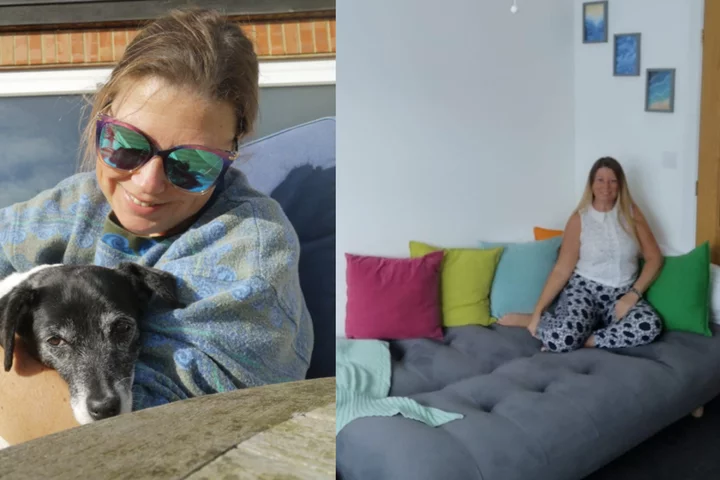
Meet the former therapist making a living as a professional cuddler
A professional cuddler who makes a living giving clients hugs has said people travel from all over the globe to receive the cuddle therapy she offers which is “far less intimate than a massage” and helps people from “all walks of life”. Natasha Wicks, 44, from Coventry, West Midlands, says that despite criticism, cuddling is scientifically proven to release happy hormones like dopamine and that a lot of her clients are “the big spoon in life” and go to her for emotional support that they do not have at home. As such, many of her clients are caregivers and most of them join Natasha for two-hour hugging sessions, costing £70 an hour. The sessions vary depending on what the client wants, some having “emotional hugs”, others talking more and some wanting to “sit at opposite ends of the sofa with our legs and feet entwined”. Natasha became a cuddle therapist in 2015 and, while she has had comments online from people criticising the practice, she said that her family and friends were unsurprised when she first started giving professional cuddles. She said: “They all said to me that I give the best cuddles so it’s not surprising that I’d start doing it as a job. “It’s very much what I do, I help people and want to make people feel better. It’s a natural thing when someone is going through a tough time to want to give them a hug. “Cuddle therapy might not be as widely accepted in society but it’s far less intimate than other things like massages which are seen as normal.” Prior to becoming a cuddler, Natasha originally trained as a CBT therapist and counsellor. She said: “There’d be situations where I would be talking to someone and they’d really need a hug, but obviously, you’d have professional boundaries in place and it wouldn’t have been appropriate. “It was just a really natural thing. One client had finished her final session and we had agreed that she wasn’t my patient anymore so we hugged goodbye. She said to me that she’d wanted to do that for a long time and I thought ‘me too’.” Looking into cuddle therapy, which she said was increasing in popularity in 2014, Natasha took a training course. By 2015, she was a qualified cuddler and started taking on new patients for cuddle sessions. Natasha provides a minimum session of one hour but said most people go for at least two hours, sometimes longer if they are receiving more than one type of therapy. She said: “I always give people a hug on the doorstep when they arrive and then they’ll come in and relax, and we’ll have an initial chat about what brings them here. After that, I’ll put on some ambient music and we’ll have a cuddle on my cuddle sofa. “It can be daunting coming into a stranger’s house and I can tell the difference in them from arriving to leaving. The first hug they might be angled away from me but when we’re hugging goodbye, I can get my head in between their neck and shoulders and you can almost feel that a weight has been lifted from them.” There is not one type of person that visits Natasha for cuddles, but she says that a lot of her clients are caregivers. She said: “There’s all sorts of people who come for a cuddle, from people who have moved away from home for the first time and just want a mum hug all the way to people in their 80s. “I’m inclusive of all genders and all ages. I get a lot of clients who are the carers of their family and they are so busy looking after other people, and probably giving the hugs and support to other people, that they don’t have that for themselves. “A lot of people that come to see me are generally people are the big spoon in the life – they take care of others and don’t want to show a vulnerable side to people because they don’t want people to worry that they can’t cope. “I get a lot of carers, a lot of NHS staff, a lot of mums, a lot of people that are in a world where they have to be the strong one in the situation and they just want to be able to come here and let their guard down.” Natasha’s priority is to make people feel at ease when they arrive as she said it can be “nerve wracking” turning up at someone’s house for a hug. Setting out clear boundaries prior to meeting, the therapist has said that the patients she has welcomed into her home have all been respectful. She added: “I always say to people that when your body relaxes, your tummy might crumble and mine might too, but that people don’t need to worry about it. Sometimes people fall asleep and they might snore or fart, it’s just natural things that happen. It’s happened twice where someone has got an erection and that’s fine, I have boundaries and we’ll just change position. “I want people to feel reassured that, as soon as they get in, they feel comfortable.” Despite the unconventional therapy, when Natasha first took on cuddle clients, she said her family were completely “unsurprised” and the step from CBT therapy to cuddle therapy was a “natural evolution”. While Natasha focuses her time on a holistic approach for treating people, she noted that there is also neuroscience behind cuddles. According to the 44-year-old, physical touch activates the brain’s orbitofrontal cortex and cuddling releases oxytocin, dopamine and serotonin. Now, Natasha also does EMDR therapy and is a mental health swim host, and has clients travel from all over the globe to receive her hugs. She said: “Working from Coventry is brilliant because I’m only nine minutes on the train from Birmingham Airport and people come to visit me from all over. I get a client from Belgium, someone from Ireland and people from all over the UK who come to see me. “I wanted to find a sofa bed that just looked like a big comfy sofa for cuddle sessions. I’d started off with a big L shaped sofa but after about five years, it was sagging a bit, there’d been a lot of healing done on that sofa and it was time for a new one. “Now I have a sofa bed in my living room that I use as my cuddle sofa. It’s in the living room and it’s used for everyday life, watching TV with my partner, having people round and also for my work.” Breaking down the taboo around cuddle therapy, Natasha hopes more people will embrace the alternative treatment. She added: “As it’s become more popular, more people are becoming qualified as cuddlers and I think that’s great. “I’ve had comments online before of people thinking it’s weird or not understanding but there are other things we accept in society that are much more intimate than cuddles, like massages. “It’s not weird, it’s actually a really lovely thing to be able to make another soul feel better for a while.” Read More Charity boss speaks out over ‘traumatic’ encounter with royal aide Ukraine war’s heaviest fight rages in east - follow live What is ‘beer tanning’ and why are experts warning against it? Christian Cowan: Designing is like dreaming Deborah James’s daughter launches anniversary clothing line for Bowelbabe Fund
2023-07-26 21:55

New warnings about ‘concerning’ rise in at-home cosmetic dentistry
There has been a 116% increase in DIY cosmetic dentistry over the past five years, new research has found, with social media driving up demand. Bupa Dental Care found that 20% of people who have attempted at-home treatments on their teeth had done so with teeth whitening kits, 13% had used plaque scraping gadgets, and 11% had purchased braces online. The research, which surveyed over 2,000 consumers in the UK – nearly 20% of whom were found to have tried dentistry products at home – was done in collaboration with Censuswide, a global insight-driven research company. Shockingly, it also found that 16% of those people were influenced by hacks on TikTok and other social media sites to create their own teeth-whitening concoctions with hydrogen peroxide. The chemical can cause mouth infections or other wider health complications, if not used correctly, Bupa said. “DIY dental treatment can seem like a big cost saving initially,” Chris Hanford, a Bupa Dental Care dentist, said: “However, such treatment can cause irreversible damage that can not only lead to pain but end up being more complex and costly to fix. “The problem is that dental treatment at home is not professionally prescribed or supervised – and there’s the added risk of buying counterfeit whitening kits.” One respondent, who experienced negative side effects from DIY dentistry, said: “It doesn’t last and constantly costs more money on top of what has already been paid.” Dr Safa Al-Naher, director and principal dentist at Serene, said: “The marketing for online braces – clear and called aligners – is really good. It’s also a really attractive prospect to people who want a quick fix. This is the day and age of Amazon, it’s one click and you get it.” But the consequences of DIY dental treatments vary. The research found that 74% of people who’d done it needed emergency treatment to fix their issues. One in six people out of the group reported that they now have damaged tooth enamel, brittle teeth, tooth and gum sensitivity, weakened and brittle teeth bruising or damaged dental bone. “Any at-home teeth-whitening can cause damage to tooth enamel, give rise to tooth decay, as well as gum and tooth sensitivity – particularly if they’re used too frequently. Poorly planned or ill-fitting braces can cause anything from wobbly teeth or gum recession to damaged bone,” Hanford adds. It’s why Al-Naher is “very worried and concerned” about the rise in at-home cosmetic dentistry. “I have personally seen many cases that have come through to me, some disastrous. It is a false economy ultimately, as you spend your money on these products initially and then you spend more money again to get them fixed,” he said. “This discourages people from taking care of their teeth on a regular basis, visiting their dentists every six to 12 months.” Read More Charity boss speaks out over ‘traumatic’ encounter with royal aide Ukraine war’s heaviest fight rages in east - follow live What is ‘beer tanning’ and why are experts warning against it? Christian Cowan: Designing is like dreaming Deborah James’s daughter launches anniversary clothing line for Bowelbabe Fund
2023-07-26 21:48
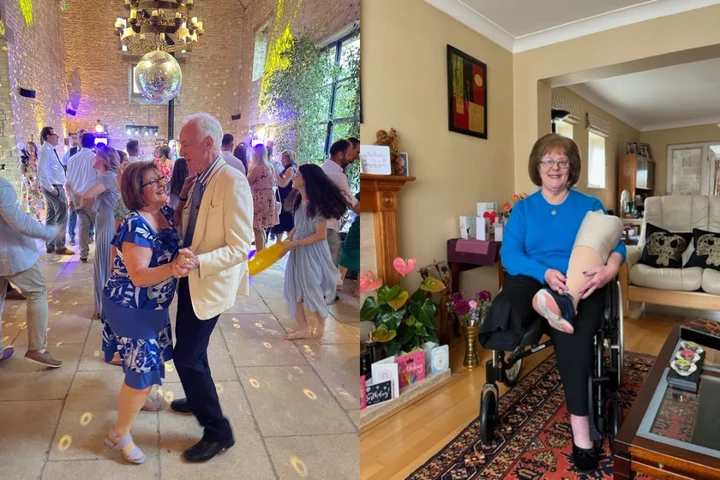
Grandmother with rare cancer that led to amputation shares first warning sign
A grandmother who was diagnosed with a rare cancerous tumour after her ankle “looked a bit swollen” had to have her leg amputated, but she is now walking with a prosthetic and has achieved her goal of waltzing again with her husband. Shirley Parnell, 75, a retired production coordinator, who lives in Kings Langley, Hertfordshire, with her husband, Lawrence, 76, a retired chartered surveyor, noticed a lump on her ankle in July 2022, and little did she know, it would lead to a devastating diagnosis. Shirley “assumed it would be something that (doctors) could fix”, but, after several scans, she was diagnosed with spindle cell sarcoma, a rare malignant cancerous tumour, and was told a leg amputation would be the only way forward. The mum of two and grandmother of two felt “shocked and in disbelief” as it “hadn’t even crossed (her) mind” that she was going to be diagnosed with cancer. After the surgery, Shirley had an “overwhelming sense of relief” and focused on getting better – to motivate herself, she set herself the goal of being able to dance with her husband again. But, while learning to walk again, Shirley was diagnosed with metastasis lung cancer and could not help but feel “a little bit cheated” as her parents lived until their 90s and she now knows “that’s probably not going to happen.” She did not let this get in the way of her achieving her goal, and in the middle June 2023, she danced with her husband again at a friend’s wedding and said she “had a real sense of achievement”. In July 2022, Shirley got her first warning sign of cancer when she experienced pain in her right ankle. Shirley told PA Real Life: “My ankle started to look a bit swollen – at first, I didn’t think anything of it as I assumed I had just knocked it on something in the house and not realised, but then I noticed a lump. “The lump kept moving around and the pain started to get more intense. So much so that I decided to go and see my local GP.” Shirley’s GP thought it could be a blood clot, so she was prescribed cream and tablets, but after a week, nothing improved. She was then referred to Watford General Hospital for a blood test and an X-ray. Shirley said: “I had just assumed it would be something that they could fix with some medication and the thought of something more serious didn’t really cross my mind. “It was only when they said that the X-ray had come back showing some abnormalities and they wanted me to have an MRI scan, a CT scan and a biopsy that I started to worry. “A few weeks went by, and I tried not to think about the results but then I got a call saying the results were back and they wanted to see me, and I just felt like it was going to be bad news.” At the appointment, Shirley was told she had spindle cell sarcoma, a rare malignant cancerous tumour which can develop in the bone or soft tissue. The doctor suggested that the only option for Shirley was to have her leg amputated to remove the tumour. She said: “As he said those words, I felt shocked and disbelief. “I thought at the time, only last week I was living my life normally, doing things I would come to take for granted such as walking to the shops or going to a Pilates class. “It hadn’t even crossed my mind that it might be cancer, let alone that I would lose a limb because of it.” So, on October 24 2022, at the Royal National Orthopaedic Hospital in Stanmore, Greater London, Shirley had the surgery. She said: “I was very nervous going into surgery but funnily enough I was okay once it was done. “I just had an overwhelming sense of relief that that part was finished. “Everyone has always said to me that I am a very determined person and after the surgery, I just started to look to the future as I felt everything was getting better, so I focused on working towards that.” But, once her leg was amputated, Shirley could not help but feel like she had lost some independence. She said: “Before I could just pop out to pick up some essentials but I had to rely on others to help me, something I am learning to get better at. “I’m so grateful for my husband running me around though.” On January 27 2023, Shirley had a cast made for her prosthetic leg, and it was fitted a week later. She said: “Then came the long and challenging journey of learning how to walk again. “The staff at the Prosthetic Rehabilitation Unit at the Royal National Orthopaedic Hospital were amazing and their support was what got me through those first few weeks and helped me get used to my new way of moving. “I felt strange but excited with my new leg – it felt like it was a real step forward into being more independent.” When in physiotherapy, Shirley made it her goal to be able to dance at her friend’s wedding with her husband. She said: “My husband and I always loved dancing – he joked that we’ll be doing a jive, but I said maybe a slow waltz.” But, at the end of April 2023, she was diagnosed with lung cancer. She said: “My parents lived until they were well into their 90s and I’ll be honest, I fully accepted with my family history that I would do the same. “So it came as a bit of a shock that I now know that that’s probably not going to happen. “I felt a little bit cheated, I suppose, but the other thing it has made me realise is that there are people a lot worse off than me.” Determined not to let the diagnosis impact her goal, Shirley practised walking even more, and at the middle June 2023, they danced together at the wedding. She said: “It was wonderful, I had a real sense of achievement, and being able to have a few dances during the evening was wonderful. “My husband was really proud of me too. “My family have been unbelievably supportive, I can’t thank them enough. “They were so happy for me that day.” Now, Shirley remains under the hospital’s care, having regular scans, and has since passed her driving assistance test. She is also raising money for the Royal National Orthopaedic Hospital Charity for its Impossible Possible campaign. Looking back on the last few years, she said: “I appreciate things a lot more now – I take time to appreciate my garden, the flowers blossoming, and my family. “I feel so lucky that I could have the amputation, and it puts things into perspective definitely.” Read More Mother reveals bruise on her toddler’s eye led to cancer diagnosis Jonnie Irwin details experience with palliative hospice care Ben Cohen’s ex-wife says she had only ‘one symptom’ before cancer diagnosis What is cardiac arrest? The condition that LeBron James’ son suffered from Mom left ‘appalled’ after water park says she can’t breastfeed son in lazy river Government has more work to do to ensure families secure quality childcare – MPs
2023-07-26 19:50

Woman rescued from mountain after trying to find scared pet parrot
Mountain rescuers came to the aid of a woman and her pet parrot in the United Kingdom this week after she became stranded trying to find one of her feathered friends, who was scared off by a peregrine falcon.
2023-07-26 19:26

Edmunds compares: 2023 Honda Accord vs. 2023 Kia K5
The Honda Accord, fresh from a recent redesign, is back to take on the South Korean equivalent, the Kia K5
2023-07-26 18:46

Christian Cowan: Designing is like dreaming
Designer Christian Cowan had a full circle moment when he recently dressed pop legend Kylie Minogue. “There are two moments when I decided I wanted to be in fashion, and they’re both around Kylie Minogue,” Cowan remembers. “One was in Borders bookshop in Cambridge [where Cowan grew up], my mum was getting a coffee and I was waiting – on the TV was the Can’t Get You Out Of My Head music video. I was like, ‘What is that? That is what I need to do’. “Then for my 12th birthday, my mum was really sweet and got me tickets to see Kylie’s X tour in the O2. It was right in the nosebleed seats at the back, and I was living my best life.” Cowan designed a red jumpsuit with zips for Minogue to perform in New York, and says: “To dress people like that, people who I really looked up to and still look up to is always an honour.” And Minogue isn’t the only celebrity who has worn Cowan’s colourful, whimsical designs. Pretty much any star you can think of, Cowan will have dressed – Lady Gaga, Sam Smith, Lizzo, Lil Nas X, Heidi Klum, Cardi B, Miley Cyrus – the list goes on. While pop stars definitely seem to gravitate to his work, Cowan says there’s no real limit to who wears his clothes. “The Christian Cowan person is anyone, but it’s someone who wants to enjoy themselves, it’s someone who wants to be complimented and get attention. It’s someone who enjoys the fun of dressing up – our customers in general, they’re not really dressing for the gaze or perspective of anyone else – they’re just feeling f****** fabulous.” Cowan went to university in London and now resides in New York – and he says he gets inspiration from both major fashion hubs. The US “leans more into maximalism, and [is] not afraid of opulence and showing off, which is very much part of my brand”, he reflects. “And the UK I’d say is more [about] pushing the boundaries and trying out new things.” Ultimately, both cities are “incredibly fashionable and stylish and have created original thinkers – so I feel very lucky to be between the two”. Cowan established his eponymous label in 2016 so feels like an industry stalwart by now, but he’s still only 29 years old. “I started my brand and career very young,” he admits. “I would definitely say it’s grown up with me – the collections that I put out at the beginning are by no means the collections I’m putting out now.” But he doesn’t feel embarrassed when looking back at earlier work, instead calling his collections “like a diary”. “You can see as I grew up, the big life experiences that happened influenced [my style]. To say it has matured – maybe that’s the wrong word – but I would say my references have gotten more expansive with time. I look further than I used to – before it was like, who was next to me in the club.” While he doesn’t go to the clubs as much as he used to (“I’m like an old man!”), he occasionally pops in (“I love to see what my friends are wearing”), while getting inspiration from elsewhere as well. “I’m definitely a child of the internet, the internet is a huge part of it. I think designing is almost like dreaming – it’s a random compilation of everything you’ve seen, all smudged into one thing.” Cowan has made a name for himself as someone who loves to collaborate, and he often gets inspiration from his creative partners – ranging from the Teletubbies to Crocs, and now, Candy Crush Saga, who he’s designed an exclusive garment for. Called ‘The Sweet Seat’, it’s a one-of-a-kind, wearable garment inspired by the dreaded task of finding a seat to play on public transport. “Collaboration is the key to success in general in life – work, personal, everything,” he muses. “So when doing these collaborations, whether it’s a dress for Lady Gaga or this Candy Crush partnership, it’s always super collaborative. I want their opinion, I want their input, I want both partners involved and to be excited. “Especially with a celebrity wearing the clothes as well, you want them to feel amazing and excited to wear the piece – you don’t bully them into wearing something they’re not fully down for. You always have a better result if you collaborate.” Working with Candy Crush gave Cowan a welcome pause from designing his next New York Fashion Week collection, set to debut in September. “We’re doing a few things we’ve never done before that I think will be surprising to people – I just can’t wait. It’s our biggest show, the collection’s over double the size of any collection we’ve ever done before,” he shares. With designing collections for fashion week twice a year, making bespoke outfits for celebrities and all the extra projects in between, does Cowan ever suffer from fashion burnout? Cowan admits to having “brief moments in my past” where he’s struggled, but adds: “When you feel that it means you need to try something new, and I never had it again after I realised that. “I make sure I’m filled with creative, fun projects – I don’t think I’d ever get burnt out. I want to be doing this until the day I die.” The limited-edition Sweat Seat will be available for purchase on christiancowan.com/candycrush for £786.92 from July 26. Download Candy Crush today on Google Play or the App Store. Read More Charity boss speaks out over ‘traumatic’ encounter with royal aide Ukraine war’s heaviest fight rages in east - follow live Deborah James’s daughter launches anniversary clothing line for Bowelbabe Fund Government has more work to do to ensure families secure quality childcare – MPs Wall squat exercises can help lower blood pressure, study suggests
2023-07-26 17:53

What is ‘beer tanning’ and why are experts warning against it?
‘Beer tanning’ is one of the latest beauty fads to trend on TikTok, with the ‘beertan’ tag racking up over 200k views. As the phrase suggests, beer tanning means applying beer to the skin while sunbathing, in the belief it will enhance the tanning process. Some fans of the method on social media have been applying beer as well as SPF, while others have skipped sun-care altogether and simply rubbed beer onto their skin. What is ‘beer tanning’ and is it safe? “The beer tanning trend involves using beer as an alternative to traditional tanning lotions to achieve a sun-kissed glow. Proponents of this trend claim that the sugars and acids in beer can help darken the skin, and potentially provide additional benefits due to the presence of antioxidants and vitamins in some beer types,” Caroline Brooks, skin specialist and founder of The Glasshouse Salon & Spa, told PA Media. “However, it’s important to note that there is no scientific evidence to support the effectiveness or safety of using beer for tanning purposes.” Serious health risks Dr Maham Khan, consultant dermatologist at the Cadogan Clinic, stressed it’s “crucial to approach this trend with caution” as there are potentially serious sun safety concerns. “As a consultant dermatologist treating patients with skin cancer on a daily basis, I feel compelled to stress the utmost importance of exercising caution and mindfulness when it comes to the TikTok trend of ‘beer tanning’. While the desire to achieve a glowing tan is understandable, it is crucial to approach this trend with caution and prioritise sun protection,” said Khan. “Applying beer to the skin in the belief that it enhances tanning is a questionable practice that lacks scientific evidence. More importantly, this method does not provide any protection against the harmful effects of ultraviolet (UV) radiation from the sun. “UV radiation is a known carcinogen and a major contributor to skin damage, which can manifest as sunburn, premature ageing, and an increased risk of skin cancer, including melanoma.” Protecting your skin in the sun is vital SPF is important for all skin types and skin tones. While it’s especially vital for people with naturally pale complexions, even those who don’t think they have a tendency to burn need to protect themselves in the sun. “I cannot stress enough the significance of using quality and appropriate SPF products to shield the skin from harmful UV rays,” Dr Khan added. “Sunscreen with a high SPF rating, along with broad-spectrum protection, is essential to safeguard the skin effectively. “However, it’s crucial to note that sunscreen alone may not offer complete protection, and additional measures such as seeking shade, wearing protective clothing and avoiding sun exposure during peak hours, are equally vital. “Furthermore, it is imperative to understand that a tan is not a sign of healthy skin, but rather an indication of damage. Even if individuals manage to achieve a tan through unconventional methods like beer tanning, it should not be considered a safe or desirable practice.” Is it ever worth trying a beer tan? According to the experts – no. If you do enjoy a beer at the beach, stick to drinking it (preferably under a nice shady umbrella). “The safest and most effective way to achieve a sun-kissed glow is by using self-tanning products or spray tans, that are specifically formulated for this purpose and have undergone rigorous testing to ensure their safety and effectiveness,” said Brooks. “Always prioritise the health and wellbeing of your skin when considering any beauty or tanning trend.” Dr Khan added: “I strongly advise against engaging in the beer tanning trend or any other unproven and potentially harmful methods of tanning. Instead, let’s be responsible and informed about the risks associated with sun exposure, diligently using SPF protection and taking steps to safeguard our skin. “By prioritising sun safety, we can enjoy the outdoors responsibly, while minimising the risk of skin damage and potential health consequences.” Read More Charity boss speaks out over ‘traumatic’ encounter with royal aide Ukraine war’s heaviest fight rages in east - follow live Christian Cowan: Designing is like dreaming Deborah James’s daughter launches anniversary clothing line for Bowelbabe Fund Government has more work to do to ensure families secure quality childcare – MPs
2023-07-26 17:49
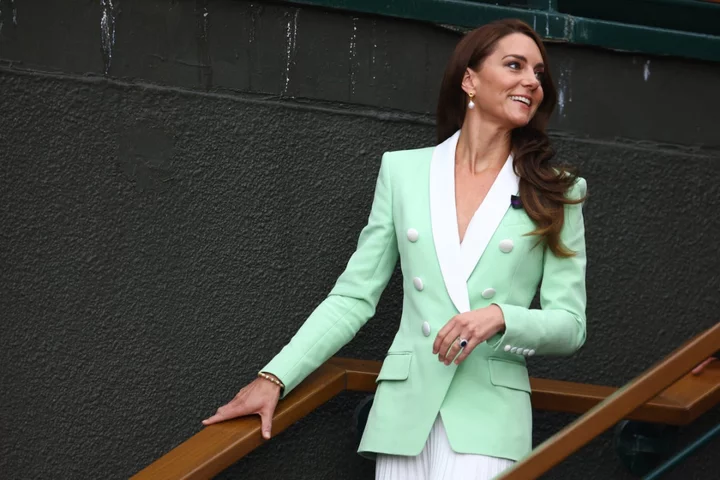
Kate Middleton’s taste in jewellery is a ‘disappointment’, says former Vogue editor Suzy Menkes
The Princess of Wales has been labelled a “disappointment’ with regards to her approach to jewellery. Former Vogue editor and fashion critic Suzy Menkes made the remarks during an interview on the newest episode of her podcast Creative Conversations. Speaking to British Vogue’s jewellery editor Carol Woolton, the two discussed and analysed some of Kate Middleton’s recent style choices, explaining to listeners that as a senior member of the royal family, she would surely have access to some of the finest jewels in the country. “The Princess of Wales is a bit of a disappointment about jewellery,” said Menkes. “She gives the impression that she only puts it on when she absolutely has to.” The 79-year-old critic continued: “I imagine her looking beautiful in one of those gowns behind the scenes and then pulling a face as if to say, ‘Do I have to wear this?’ “She doesn’t give any sense of adoring jewellery and being pleased to put it on.” Menkes went on to suggest that Queen Camilla seems far more interested in jewellery, stating: “[Kate] doesn’t seem to have Camilla’s joy at wearing jewellery.” She went on: “We now have a new Queen, so presumably she has a first opportunity to look at the jewels. “We can imagine that the next in line to the throne’s wife would be something that was very special, so will we see Catherine wearing jewellery that is more dramatic, that is more personal to her? I don’t know. I can’t help feeling with things of beauty, you either love it or you don’t.” Later in the podcast, Menkes went on to discuss some of the controversy that the royal family’s jewellery collection has garnered over the years. “It’s one of these strange secrets,” she said. “It’s not discussed, and I can see why because some of the pieces are dubious. They came from India. “I won’t say they were stolen but they were perhaps given and taken by the British Royal Family. They weren’t stealing it but they were taking over a country at that time, and and taking jewels they thought were an attractive thing to take back to England with them.” Read More Kate Middleton’s sweet tradition for Prince George’s birthday Kate Middleton and Princess Charlotte wear matching ruffles for eight-year-old’s first Wimbledon Adorable moment young boy meets Kate Middleton at Wimbledon Fans defend Prince Harry and Meghan Markle amid breakup rumours Kate Middleton’s sweet tradition for Prince George’s birthday Kate Middleton and Princess Charlotte wear matching ruffles for Wimbledon finals
2023-07-26 17:20
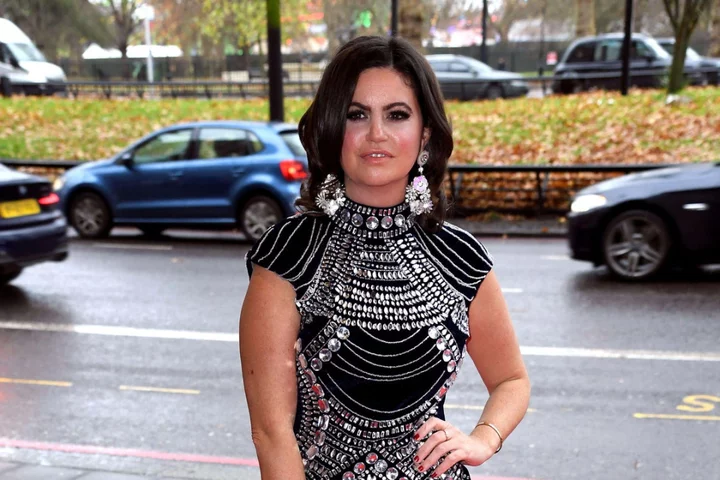
Deborah James’s daughter launches anniversary clothing line for Bowelbabe Fund
The daughter of Dame Deborah James has helped create a one-year anniversary collection of her late mother’s In The Style clothing line to continue raising funds for cancer research. Dame Deborah raised more than £1.7 million for her Bowelbabe Fund when she launched her fashion collection last year, which featured T-shirts with the words Rebellious Hope across the chest. In memory of her late mother, Eloise James has collaborated with In The Style to create an anniversary clothing line using Dame Deborah’s favourite prints and colours. In a video shared on Instagram, she said: “I am so excited to be working with In The Style to help create the one-year anniversary collection of my mum’s line. “I know she loved making this collection and so did I. She got all of her favourite patterns and designs so we took them out and put them into this new collection so I really hope you enjoy it. “100% of the profits are going to the Bowelbabe Fund and we’re keeping everybody in mind while doing this, this collection is for everybody.” You, Me And The Big C podcast host Dame Deborah, known as Bowelbabe online, died in June 2022 at the age of 40 after suffering from bowel cancer. She set up the Bowelbabe Fund for Cancer Research UK which has raised more than £10 million. On Instagram, In The Style said: “Just over a year ago, we launched a very special collection with our hero, Dame Deborah James. “Captivated by her rebellious hope and inspiring journey, together we created a range to raise awareness of her life-changing Bowelbabe fund. “This was something that Deborah felt really passionate about and she really put her all into creating this range with the team. “She had an immense love for fashion and the way you can use clothes to ‘make you feel better & get you through the day’, which is something we wanted to champion throughout her collections.” The online fashion house ​said despite raising almost £2 million through her collection, “in true Deb style, we’re not done yet”. “We promised Deborah that we would work closely with her family to continue to spread her message of hope and positivity and help keep her legacy going,” it said. “With this in mind, we are thrilled to announce that we’ve collaborated with her daughter Eloise James over the past few months to bring you a new collection! “This stunning range includes a variety of dresses, skirts, tops and more in sizes six to 28, and Eloise and the team have included many prints and colours that were Deborah’s favourites. “We hope you love the collection as much as we do and continue to support Deborah’s charitable legacy with these beautiful pieces.” Read More Charity boss speaks out over ‘traumatic’ encounter with royal aide Ukraine war’s heaviest fight rages in east - follow live Government has more work to do to ensure families secure quality childcare – MPs Wall squat exercises can help lower blood pressure, study suggests Wall sits and planks the best exercises for lowering blood pressure, study suggests
2023-07-26 16:49
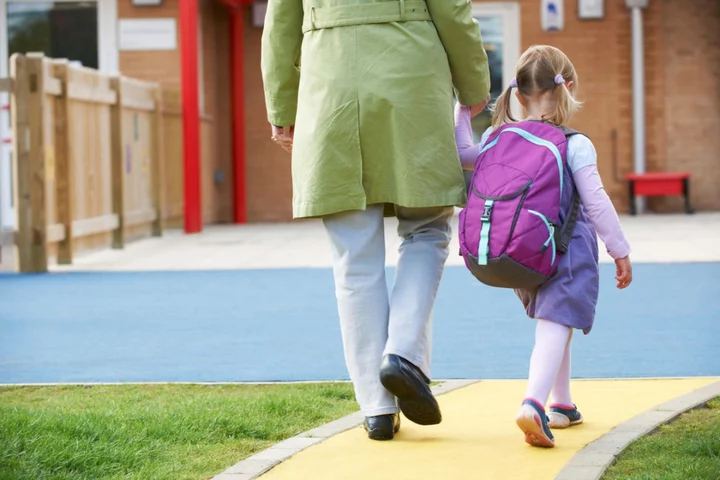
Government has more work to do to ensure families secure quality childcare – MPs
The Government has more work to do to address “structural problems” in the early years system to ensure families benefit from high-quality affordable childcare under its reforms, MPs have said. Plans to expand the number of subsidised childcare places for working parents in England “should not come at the expense of quality”, the Commons Education Select Committee has warned. From September, the Government will change minimum staff-to-child ratios from 1:4 to 1:5 for two-year-olds in England, but it will remain optional. The group of MPs said it is “deeply concerned” about the plans and it is calling on the Government to reverse the changes “if quality is degraded”. Chancellor Jeremy Hunt announced reforms in the Budget in March which will allow some families of children as young as nine months in England to claim 30 hours of free childcare a week. Simply extending the number of hours that the Government calls free will not work unless the funding rates accurately reflect the costs of providing high quality early education and childcare Committee chairman Robin Walker From April next year, working parents of two-year-olds will be able to access 15 hours of free childcare. This will be extended to working parents of all children older than nine months from September next year. From September 2025, working parents of children under five will be entitled to 30 hours of free childcare per week. The Education Select Committee said it was a “welcome investment” following concerns raised by parents and early years providers during its inquiry about “affordability and sustainability”. The report added: “However, this investment is much overdue and more will need to be done to address the structural problems in the ECEC (Early Childhood Education Care) system if the funding increases are to be implemented effectively. “In particular, close attention should be paid to effective funding distribution. Settings in disadvantaged areas already struggle more than those in more affluent areas, yet we know that it is children from disadvantaged families that can benefit the most from high-quality ECEC.” The Treasury “missed an opportunity” to reform tax-free childcare and increase the flexibility of the system under its plans to expand free childcare for working parents, the report said. Under the current system, working parents of three and four-year-olds in England are eligible for 30 hours of free childcare per week. The tax-free childcare scheme also allows eligible working families to claim 20% government support with their childcare costs, up to an annual limit of £2,000 per child. The Commons Education Select Committee report said the requirement for parents to reconfirm their eligibility every three months for the 30 hours entitlement and tax-free childcare scheme is “unduly onerous” and should be reduced to once per year. Committee chairman Robin Walker said: “The childcare market is facing significant challenges in affordability and availability, with unprecedented staff turnover and nurseries closing, despite massive demand from parents who want a career and to provide for their families but struggle to find affordable services. It is clear that ministers have more work to do to address this. “Simply extending the number of hours that the Government calls free will not work unless the funding rates accurately reflect the costs of providing high-quality early education and childcare. “We have heard that many settings rely on charging more for the children who attend them outside of the funded hours. It is therefore essential that ministers reduce burdens on the sector and provide adequate funding for all the stages of early education.” He added: “Staff are the lifeblood of this sector and the huge expansion of subsidised childcare will only be successful if we can stem the tide of people leaving the workforce. “There needs to be a revamp of career development, with improvements to pay, progression and conditions so that the profession is given the respect and status it deserves.” Not only have years of severe underfunding plagued the sector but the worst staffing crisis in decades has created a perfect storm which must be addressed if the sector has any chance of survival in the coming years Neil Leitch, Early Years Alliance The cross-party group of MPs is calling on the Department for Education (DfE) to “work closely” with childcare providers and local authorities across the country “to set the funding rate at a sufficient level.” It added that the DfE should stop describing the 30 hours offer as ‘free hours’ and instead refer to it as ‘funded’ or ‘subsidised’ hours to “improve parental trust” in the childcare subsidy system. Neil Leitch, chief executive of the Early Years Alliance (EYA), said: “Not only have years of severe underfunding plagued the sector but the worst staffing crisis in decades has created a perfect storm which must be addressed if the sector has any chance of survival in the coming years. “If that wasn’t bad enough, it’s likely that the upcoming sector expansion will be dangerously underfunded and will place unrealistic expectations on providers already on the brink.” He added: “For the committee’s findings to truly have a lasting impact, we hope against hope that it finally wakes the Government up to the reality of the situation facing families and providers and prompts urgent and effective action.” Last week, the Government said reforms expanding the amount of free childcare for parents will be “properly and fairly funded”. The DfE said its proposed new funding formula, which is now out for consultation, provides “additional funding for areas of deprivation”. The increased funding will see the expected average rate paid to local authorities for 2024/25 to be set at £8.17 for two-year-olds and £11.06 for under-twos, the DfE said. A Government spokesperson said: “We are rolling out the single biggest investment in childcare in England ever, set to save a working parent using 30 hours of childcare up to an average of £6,500 per year and give children the best quality early years education. “To make sure that we are supporting our fantastic early years workforce, we will be investing hundreds of millions of pounds each year to increase the amounts we pay childcare providers. We also are consulting on how we distribute funding to make sure it is fair.” Read More Charity boss speaks out over ‘traumatic’ encounter with royal aide Ukraine war’s heaviest fight rages in east - follow live Wall squat exercises can help lower blood pressure, study suggests Wall sits and planks the best exercises for lowering blood pressure, study suggests Everything you need to know about using a defibrillator
2023-07-26 16:30
